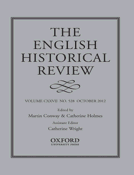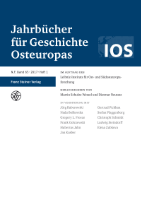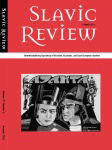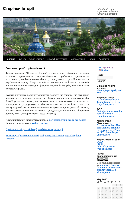
SLAVONIC AND EAST EUROPEAN REVIEW
Scope & Guideline
Navigating the Intricacies of Eastern European Scholarship
Introduction
Aims and Scopes
- Historical Analysis:
The journal focuses on historical narratives and critical analyses of events across Eastern Europe, from imperial histories to the impacts of the Cold War and post-Soviet transitions. - Cultural Studies:
It explores the cultural dimensions of Eastern European societies, including literature, art, music, and their socio-political contexts, emphasizing the interplay between culture and identity. - Political Discourse:
The journal examines political movements, ideologies, and governance structures in Eastern Europe, scrutinizing both historical and contemporary political phenomena. - Transnational Perspectives:
There is a strong emphasis on transnational studies, investigating how historical processes in Eastern Europe intersect with global trends, including migration, nationalism, and cultural exchange. - Social Dynamics and Identity:
The journal addresses social structures, ethnic identities, and the dynamics of power in Eastern European societies, including issues of gender, class, and race.
Trending and Emerging
- Political Martyrdom and Resistance:
A notable trend is the exploration of political martyrdom, particularly in the context of revolutionary movements and dissidence in Russia and other Eastern European countries, highlighting the role of individual narratives in broader political resistance. - Cultural Memory and Identity:
There is an increasing focus on cultural memory, identity formation, and the legacies of historical events, particularly in relation to the Soviet past and national identities in post-Soviet states. - Environmental Studies:
Emerging themes include environmental history and the impact of climate change, reflecting a growing recognition of environmental issues in the context of Eastern European studies. - Transnational Migration and Diaspora Studies:
Research on migration patterns and the experiences of diasporas is gaining traction, emphasizing the interconnectedness of Eastern Europe with global migration trends. - Digital Humanities and New Methodologies:
The integration of digital humanities in research methodologies is becoming more prominent, with scholars employing new technologies to analyze texts and historical data.
Declining or Waning
- Traditional National Histories:
There seems to be a decline in articles focusing solely on traditional national histories without integrating broader transnational or comparative perspectives. - Soviet Era Nostalgia:
The romanticized narratives of the Soviet past are becoming less prominent, as contemporary scholarship increasingly critiques this period with a focus on its complexities and contradictions. - Exclusively Literary Studies:
While literature remains a core subject, the focus on purely literary studies without connecting to cultural or historical contexts appears to be waning, as interdisciplinary approaches gain prominence. - Cold War Dichotomies:
Research that strictly adheres to Cold War binaries (East vs. West) is declining, with a shift towards more nuanced understandings of the period's complexities. - Ethnic Conflicts without Broader Contexts:
The journal has seen a decrease in articles that examine ethnic conflicts in isolation, reflecting a broader trend towards understanding these issues within global and historical frameworks.
Similar Journals

Metacritic Journal for Comparative Studies and Theory
Exploring the Intersection of Arts, Humanities, and Social Sciences.Metacritic Journal for Comparative Studies and Theory is a premier scholarly publication focusing on interdisciplinary research within the fields of Arts and Humanities, as well as Social Sciences. Published by UNIV BABES-BOLYAI, FAC LETTERS, PHANTASMA CTR IMAGINATION STUDIES, this Open Access journal has made significant strides since its inception in 2015, providing a platform for innovative comparative studies that inspire critical discourse. With an impressive Q2 ranking in both Arts and Humanities and Social Sciences, the journal showcases high-quality research that engages contemporary issues and theoretical frameworks. Its Scopus rankings further highlight its impact, with a noteworthy position in the 78th percentile for Arts and Humanities and 40th percentile for Social Sciences. As an accessible resource for researchers, professionals, and students, the journal encourages contributions that navigate complex themes of interpretation and imagination that resonate within and beyond Romanian scholarship. Discover the latest insights and foster collaborations in a dynamic academic landscape.

ENGLISH HISTORICAL REVIEW
Illuminating Historical NarrativesThe English Historical Review, published by Oxford University Press, stands as one of the foremost journals in the field of history, with a remarkable legacy that dates back to 1886. With an ISSN of 0013-8266 and an E-ISSN of 1477-4534, the journal serves as a vital platform for the dissemination of scholarly research and critical analysis among historians and researchers alike. It boasts an impressive positioning in the academic landscape, currently ranking in the Q2 category for History and occupying the 60th percentile in the Scopus ranks within the Arts and Humanities. Although it operates under a subscription model, the English Historical Review continues to attract contributions that shape our understanding of historical narratives and methodologies. Researchers, professionals, and students will find its rich content indispensable for both their studies and professional practice, making it a pivotal resource for advancing the discipline of history.

Aspasia
Bridging gender dynamics with historical insights.Aspasia is a distinguished open-access journal dedicated to the fields of Gender Studies and History, published by BERGHAHN JOURNALS and based in the United Kingdom. Since its inaugural issue in 2011 and achieving open access in 2019, Aspasia has committed to providing a platform that explores diverse scholarly perspectives on women's experiences and gender dynamics within historical contexts. With an impact factor reflective of its rigorous peer-review process, Aspasia has achieved notable rankings, including Q4 in Gender Studies and Q3 in History for 2023, indicating its growing influence within these disciplines. The journal is indexed in prominent databases, showcasing its relevance and contribution to ongoing academic discourse. Researchers, professionals, and students are encouraged to explore its rich content, fostering critical dialogue and advancing knowledge in the understanding of gender and historical narratives.

JAHRBUCHER FUR GESCHICHTE OSTEUROPAS
Exploring the Rich Tapestry of Eastern European HistoryJAHRBUCHER FUR GESCHICHTE OSTEUROPAS, published by FRANZ STEINER VERLAG GMBH, is a prominent academic journal dedicated to the exploration of Eastern European history. With its inception dating back to 1978, this journal has consistently provided a platform for scholarly discourse, contributing significantly to the understanding of the region's complex historical narratives. While the journal is not open access, it holds a solid reputation within the academic community, positioned in the Q4 quartile in history as per the 2023 category rankings, and stands at Rank #1636 within the Scopus Arts and Humanities History ranking. The convergence of its publication years throughout the decades emphasizes a long-standing commitment to historical research, thereby making it an essential resource for researchers, professionals, and students interested in Eastern European studies. Explore the intricate dynamics of historical events and cultural developments that shape Eastern Europe through this invaluable periodical.

Slovo
Uncovering Innovative Perspectives in Eastern European StudiesSlovo, published by the University College London, School of Slavonic & East European Studies, is a vital scholarly journal dedicated to the exploration of Slavic languages and cultures, as well as the broader social sciences and humanities. Established with a commitment to advancing academic discourse, Slovo serves as a platform for researchers, professionals, and students interested in the dynamic intersections of literature, history, and cultural studies within Slavic and Eastern European contexts. Although it holds a Q4 ranking in both the Arts and Humanities and Social Sciences categories, the journal’s emphasis on fresh perspectives often invites innovative contributions that challenge conventional narratives. While lacking an Open Access option, Slovo remains integral for those seeking to navigate its multifaceted terrain, ensuring that emerging scholars and established academics alike can engage with rigorous research from 2012 to 2023 and beyond. With its headquarters in London, United Kingdom, this journal not only reflects the rich heritage of its academic lineage but also fosters a vibrant community committed to the exploration of Slavic and East European studies.

SLAVIC REVIEW
Advancing Knowledge in Slavic Cultural and Social Dimensions.SLAVIC REVIEW, published by Cambridge University Press, is a prominent academic journal that delves into the rich tapestry of Slavic studies, focusing on the cultural, historical, and social dimensions of Slavic regions. With an ISSN of 0037-6779 and an E-ISSN of 2325-7784, this journal holds a significant position within the academic community, ranking in the Q2 category of Arts and Humanities (miscellaneous) and achieving a Q1 rating in Cultural Studies as of 2023. Notably, the journal has consistent relevance in the field, as evidenced by its Scopus rankings—Rank #260 in Cultural Studies and Rank #204 in Miscellaneous Arts and Humanities. Since its converged years starting from 1966 up to the present, SLAVIC REVIEW has been an essential resource for researchers, professionals, and students aiming to deepen their understanding of Slavic cultures. While it operates on a traditional subscription model and does not provide open access, the journal remains a vital platform for pioneering research and critical discourse in Slavic studies.

Intersections-East European Journal of Society and Politics
Innovative Insights into the Heart of Eastern European PoliticsIntersections-East European Journal of Society and Politics is a pivotal resource in the fields of Law, Sociology, and Political Science, published by the prestigious CENTRE SOCIAL SCIENCES, HUNGARIAN ACAD SCIENCES. Since its inception in 2015, this journal has been dedicated to exploring the complexities of social and political phenomena within Eastern Europe, making it an essential platform for scholars, practitioners, and students alike. With a focus on fostering interdisciplinary dialogue, it publishes innovative research that critically addresses pressing societal issues and challenges. Despite its current quartile ranking of Q3 in both Law and Sociology and Political Science, the journal's commitment to high-quality scholarship is evident through comprehensive peer-review processes. Accessible to a global audience, this journal aids in the dissemination of vital knowledge and serves as an invaluable asset for anyone seeking to advance their understanding of East European socio-political dynamics.

Storinky Istoriyi-History Pages
Exploring the Threads of History.Storinky Istoriyi-History Pages, published by the NATL TECHNICAL UNIV UKRAINE IHOR SIKORSKY KYIV POLYTECHNIC INST, is a prestigious academic journal dedicated to the exploration and analysis of historical narratives and their significance in contemporary contexts. With an ISSN of 2307-5244 and E-ISSN 2411-0647, the journal has embraced an Open Access model since 2012, facilitating wider dissemination of knowledge and encouraging scholarly dialogue among researchers, professionals, and students interested in history and its multifaceted impacts. Based in Kyiv, Ukraine, this journal serves as an essential platform for the publication of innovative research, critical reviews, and insightful articles that contribute to the ongoing academic discourse in historical studies. Although specific metrics such as H-index and Scopus rankings are currently unavailable, the journal is poised to enhance the visibility and impact of historical research on an international level, making it a valuable resource for those dedicated to understanding and interpreting the past.

European Romantic Review
Navigating the Complexities of RomanticismEuropean Romantic Review is a distinguished journal published by Routledge Journals, Taylor & Francis Ltd, focusing on the critical exploration of Romantic literature and its cultural impact. Since its inception in 1990, the journal has been a vital platform for scholarly discourse in the fields of Cultural Studies and Literature and Literary Theory, with an esteemed ranking in the 61st percentile for its contributions to the literature domain. Despite not being open access, European Romantic Review provides valuable insights to researchers, offering a rich repository of articles that engage with the complexities of Romantic thought, authorship, and aesthetics. The journal's commitment to advancing academic knowledge makes it an essential read for scholars, professionals, and students interested in the nuances of the Romantic era and its lasting influence on contemporary discourse.

OSTEUROPA
Navigating the Social Fabric of Eastern EuropeOSTEUROPA is a distinguished academic journal dedicated to the examination and analysis of social, cultural, and political developments in Eastern Europe. Published by BWV-BERLINER WISSENSCHAFTS-VERLAG GMBH, this journal has been a critical voice in the field since its inception in the mid-20th century, notably converging from various years to establish a comprehensive discourse on the dynamics shaping the region. With an ISSN of 0030-6428 and an E-ISSN of 2509-3444, OSTEUROPA taps into the expansive fields of sociology and political science, holding a reputable Q3 category ranking in these disciplines for 2023. While not currently an open access publication, it remains a vital platform for researchers, professionals, and students alike who seek to deepen their understanding of Eastern European affairs. The journal also ranks in the 17th percentile within the Scopus listings, underscoring its role as a significant, albeit niche, contributor to social studies and political science scholarship. Addressed from its base in vibrant Berlin, OSTEUROPA continues to foster intellectual dialogue and provide valuable insights into the complexities of Eastern European societies.